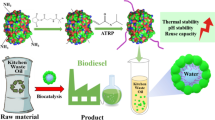Abstract
Geotrichum sp. lipase modified with a combined method composed of crosslinking and bioimprinting was employed to selectively hydrolyze waste fish oil for enrichment of eicosapentaenoic acid (EPA) and docosahexaenoic acid (DHA) in glycerides. Crosslinked polymerization by monomer (polyethylene glycol 400 dimethyl acrylate), crosslinker (trimethylolpropane trimethylacrylate), and photoinitiator (benzoin methyl ether) coupled to bioimprinting using palmitic acid as imprint molecule, resulted in much more effective enzyme preparation used in aqueous hydrolysis reaction. Since the crosslinked polymerization modification maintained bioimprinted property and gave good dispersion of enzyme in reaction mixture, the crosslinked bioimprinted enzyme exhibited higher hydrolysis temperature, enhanced specific activity, shorter hydrolysis time, and better operational stability compared to free lipase. Crude fish oil was treated at 45 °C with this crosslinked bioimprinted lipase for 8 h, and 46% hydrolysis degree resulted in the production of glycerides containing 41% of EPA and DHA (EPA+DHA), achieving 85.7% recovery of initial EPA and DHA. The results suggested that bioimprinted enzymes did not lose their induced property in aqueous environment when prepared according to the described crosslinking–bioimprinting method. It could also be seen that the crosslinked bioimprinted lipase was effective in producing glycerides that contained a higher concentration of polyunsaturated fatty acid with better yield.





Similar content being viewed by others
References
Hudson, E. P., Eppler, R. K., & Clark, D. S. (2005). Curr Opin Biotechnol, 16, 637–643.
Bagi, K., Simon, L. M., & Szajani, B. (1997). Enzyme Microb Technol, 20, 531–535.
Mateo, C., Abian, O., Lafnente, R. F., & Guisan, J. M. (2000). Enzyme Microb Technol, 26, 509–515.
Okahata, Y., & Mori, T. (1997). Trends Biotechnol, 15, 50–54.
Fishman, A., & Cogan, U. (2003). J Mol Catal B-Enzym, 22, 193–202.
Foresti, M. L., Alimenti, G. A., & Ferreira, M. L. (2005). Enzyme Microb Technol, 36, 338–349.
Yilmaz, E. (2002). World J Microbiol Biotechnol, 18, 37–40.
Okahata, Y., Hatano, A., & Ijiro, K. (1995). Tetrahedron Asymmetry, 6, 1311–1322.
Furukawa, S. Y., Ono, T., Ijima, H., & Kawakami, K. (2001). J Mol Catal B-Enzym, 15, 65–70.
Furukawa, S. Y., Ono, T., Ijima, H., & Kawakami, K. (2002). J Mol Catal B-Enzym, 17, 23–28.
González, N. H., & Braco, L. (1997). J Mol Catal B-Enzym, 3, 111–119.
Peiβker, F., & Fischer, L. (1999). Bioorg Med Chem, 7, 2231–2237.
Yan, J. Y., Yan, Y. J., Yang, J. K., Xu, L., & Liu, Y. (2009). Process Biochem, 44, 1128–1132.
Hayes, D. G. (2004). J Am Oil Chem Soc, 81, 1077–1102.
Haas, M. J., Kramer, J. K. G., Neill, G. M., Scott, K., Foglia, T. A., Sehat, N., et al. (1999). Lipids, 34, 979–987.
Shimada, Y., Maruyama, K., Sugihara, A., Moriyama, S., & Tominaga, Y. (1997). J Am Oil Chem Soc, 74, 1441–1446.
Shimada, Y., Sugihara, A., Nakano, H., Kuramoto, T., Nagao, T., Gemba, M., et al. (1997). J Am Oil Chem Soc, 74, 97–101.
Shimada, Y., Maruyama, K., Nakamura, M., Nakayama, S., Sugihara, A., & Tominaga, Y. (1995). J Am Oil Chem Soc, 72, 1577–1581.
Shimada, Y., Maruyama, K., Okazaki, S., Nakamura, M., Sugihara, A., & Tominaga, Y. (1994). J Am Oil Chem Soc, 71, 951–954.
Shimada, Y., Sugihara, A., & Tominaga, Y. (2001). J Biosci Bioeng, 91, 529–538.
Macrae, A. R. (1983). J Am Oil Chem Soc, 60, 291–294.
Mcneill, Gp., Ackman, R. G., & Moore, S. R. (1996). J Am Oil Chem Soc, 73, 1403–1407.
Sun, T., Pigott, G. M., & Herwig, R. P. (2002). J Food Sci, 67, 130–136.
Yan, J. Y., Yang, J. K., Xu, L., & Yan, Y. J. (2007). J Mol Catal B-Enzym, 49, 28–35.
Persson, M., Mladenoska, I., Wehtje, E., & Adlercreutz, P. (2002). Enzyme Microb Technol, 31, 833–841.
Yan, J. Y., & Yan, Y. J. (2008). Appl Microbiol Biot, 78, 431–439.
Liu, Y. X., Jin, Q. Z., Shan, L., Liu, Y. F., Shen, W., & Wang, X. G. (2008). Ultrason Sonochem, 15, 402–407.
Acknowledgments
This study was financially supported by the Scientific Research and Technological Development Program of Guangxi (0815006-1-2). The authors acknowledge Tingxiu Jin, Liangjun Zhou, and Xiaojun Luan for their valuable assistance.
Author information
Authors and Affiliations
Corresponding author
Rights and permissions
About this article
Cite this article
Yan, J., Li, L., Tang, Q. et al. Preparation of a Crosslinked Bioimprinted Lipase for Enrichment of Polyunsaturated Fatty Acids from Fish Processing Waste. Appl Biochem Biotechnol 162, 757–765 (2010). https://doi.org/10.1007/s12010-010-8910-7
Received:
Accepted:
Published:
Issue Date:
DOI: https://doi.org/10.1007/s12010-010-8910-7




